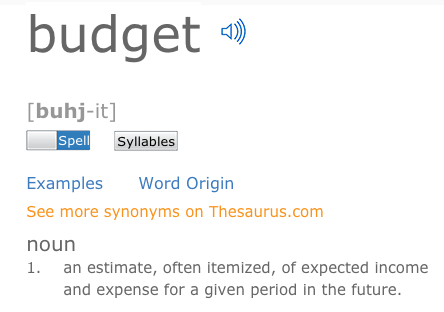Building a marketing communications budget for your nonprofit
Thanks to J. Lo, we know love don’t cost a thing, but marcom still does. Whether our marketing and communications ideas are lofty or little, things cost money. And, just as we say we can’t evaluate what we don’t measure, we also can’t spend what we don’t have.
So, what’s a budget?
I know how much communicators love math (clears throat), but having a budget is an important aspect of managing our marcom portfolio. In fact, a budget is really just an extension of our marcom strategy that is directly tied to our marketing and communications objectives. Now, if you’re trying to build a budget without objectives, I respectfully ask that you a) not do that and b) refer to an earlier post to help you on setting your objectives.

Most simply, a budget is a listing of estimated revenue and expenses for a particular time period or initiative. A budget is a planning and project management tool and it can be built for things big and small, such as an entire communications department and a single brochure.
Top 3 reasons to use a budget
It’s important for marcom professionals to use budgets. Here are the top three reasons why:
- It’s a strategic tool that lets us implement our strategy.
- It’s a project management tool that helps keep us, and our supervisors, focused on our priorities. A set budget can help stop ad hoc projects from being added to our plates, which is important to our sanity and to keep our nonprofits on-strategy.
- It demonstrates our credibility as professionals and as ‘owners’ of our departments or functions within our nonprofits. Setting and managing our own budget shows that we are organized and responsible stewards of our organization’s resources and that we understand how our role fits within the larger operations of our organizations.
7 steps to create – and manage – a marketing communications budget
A budget can be very simple and broad or quite complex and detailed; it can all depend on what it’s being used for and the amount of risk or money involved. With that said, here are some general steps and things to consider when creating a budget. These steps focus on a simple budget of expenses versus one with both revenue and expenses.
Step 1: List all the items from your objectives that have an associated cost
Start with your final, approved marketing and communications objectives. For each one, list the items that will cost money in some way, whether that’s because it needs to be purchased, designed, mailed, etc. For example, if you’re planning to add an online application form to your website, you may need to budget for a web developer or even a whole new CRM. And, if you’re a bilingual nonprofit, translation fees could be another expense related to this one objective. You would have already done some of this work when you were coming up with the objectives. (Most marcom folks within organizations do not need to include internal costs, such as salaries and office supplies, but find out what your nonprofit’s expectations are.)
Step 2: Add the ‘everyday stuff’
Start with your list from step 1, i.e. the list of all the items from your objectives that have some sort of expense tied to them. Now, add the ‘everyday stuff’ that has not been accounted for yet. These would be initiatives that are being carried over from another year. These would also include the ongoing day-to-day expenses we sometimes forget about, such as subscriptions to a stock photo resource or social media tools like Hootsuite. And, if infrastructure costs such as website hosting and URL subscriptions fall into your responsibility and budget, don’t forget to include these too.
'Start with your final, approved marketing and communications objectives.' #budgeting #NPMC Click To TweetStep 3: Create your budget document
There are thousands of budget templates and variations. Although you may have a personal preference or find a great example online, my recommendation is that you follow your nonprofit’s budget format.
In most cases, your budget ultimately feeds up into a larger, organizational budget. Therefore, using the same format as your nonprofit and organizing your budget items under your nonprofit’s existing budget lines, whenever possible, has advantages. For example, following the same format can make it easier to get your budget approved because it’s familiar and ‘fits’ the format used and managed by the people who ultimately decide if you get the money.
It will also be easier to monitor and track throughout the year to make sure your budget lines have the right things in them. For example, assuming you see your nonprofit’s monthly statements, if you see an amount showing up in a month you didn’t spend any money for that budget line, you could catch a possible error or misallocation early.
Since I have persuaded you to follow your nonprofit’s format, the next step is to get an Excel doc, or whatever type of spreadsheet software you use, of your nonprofit’s budget template. If for some reason it’s not easy for your nonprofit to give you this template document, you can re-create it in a new spreadsheet doc. Once you have the doc ready, add the budget lines that your nonprofit uses that have relevance to marketing and communications, e.g. ‘Website’, ‘Publications’, ‘Advertising’. If your organization just has one relevant budget line, like ‘Marketing’ or ‘Communications’ then all of your items would just fall under that one.
DO: Use Excel or a similar spreadsheet software to create your budget document. This will make your life easier, allowing you to use formulas to automatically keep running totals and avoid manual math errors.
Step 4: Add your budget items to your budget document
Next, add your budget items under each appropriate budget line. For example, if your nonprofit has a ‘Website’ budget line then the new online volunteer application form you’re planning to develop this year would fit under that heading.
Step 5: Source and add the estimated costs
Now that your budget document is created and the budget items are listed, you need to fill in the actual budget dollar amounts. There will be some costs that are easy to find with some Googling, like the estimated cost of a digital camera. For others, like a re-brand or video, you will likely need to have preliminary conversations with colleagues and vendors. If you see work done by another organization that is close to what you want to do, don’t be afraid to call them and ask who did the work and, approximately, what it cost.
Unless your nonprofit expects otherwise, this stage of budgeting is just to gain ballpark estimates. It takes a lot of time to get actual estimates from vendors. My recommendation is that you do enough research to make an informed estimate but not request formal estimates from vendors at this stage unless you are very confident the project and the money will be approved. It takes a lot of time for both you and the vendor to put an estimate together, so respect that effort.
EXAMPLE: Here is a very simple example of a budget format
Step 6: Get the budget approved
In many ways, your budget acts as a case to support the work you wish to do. Now that you’ve spent the time to make a comprehensive budget with informed cost estimates, follow your nonprofit’s process to get it approved. Approval may come from your supervisor or it may need to go to the Board. Regardless of how formal your process is, make sure you communicate how the budget directly ties to the marketing and communications objectives that have, ideally, already been approved.
TIP: Make sure you know if your budget is supposed to include taxes. You don’t want to find out you have 13% less budget than you thought!
Building an #NPMC budget >> 'Your budget acts as a case to support the work you wish to do.' Click To TweetStep 7: Manage it
Congratulations! Now your budget is approved. But, it’s not done. Remember, this is a project management tool. You don’t want to find out that you’ve underspent, or worse overspent, at the end of the year. It’s your responsibility to stay on top of the money you’re spending for your work or department. At any time you may be asked where you are with your budget. You should know the answer.
‘Managing’ your budget means you update the budget document when:
- A ballpark estimate becomes a formal estimate
- You have spent money
- A new budget item (and cost) is added
- An item is cancelled
As the year or project progresses, you’ll be able to see the variations in what you estimated versus what something actually cost, and you’ll see the total you’ve spent to date. To help you keep track of these numbers and where they come from, save all of your estimates and invoices in one place.
DO: Keep track of your original ballpark estimates (if these change over the course of the year/project) and all the items that make up your actual-to-date numbers by adding comments in the spreadsheet cell or in a notes section. See the budget example found above.
TIP: Make sure you understand your nonprofit’s expectations and processes for approved budgets. Some approve a budget and then it’s ‘your’ budget to manage as you see fit. For others, it’s a preliminary ‘okay’ but the expectation is that a second approval process will be done before any expense is incurred just in case those dollars are now needed elsewhere within the nonprofit or priorities have changed.
Budgets are part of a communicator’s toolbox
We may not always approach budgeting with great zest, but budgets are definitely an important tool in a communicator’s toolbox. A budget helps us plan, manage, and, ultimately, implement our marketing and communications strategy and objectives.
From seven steps to seven sins. If you’re hungry for more budget talk, read these seven deadly sins of nonprofit marketing and communications budgets by Alyssa Conrardy of Chicago’s Prosper Strategies.
I’d love to hear if you have a great piece of advice for setting or managing budgets, or if you have a budget horror story. Comment below!



 PRINT
PRINT
